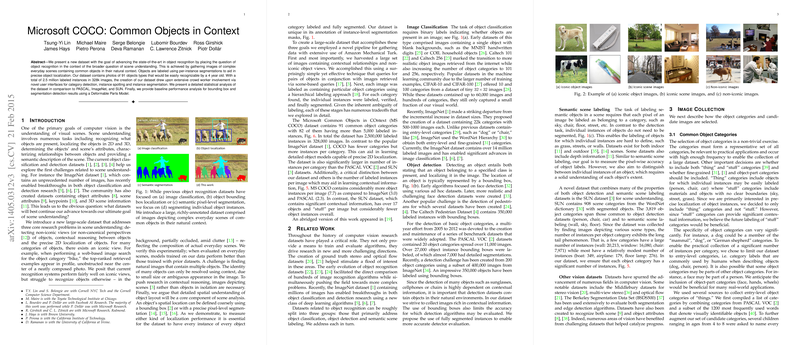Overview of Microsoft COCO: Common Objects in Context
The paper, "Microsoft COCO: Common Objects in Context," authored by Tsung-Yi Lin et al., introduces the Microsoft COCO (MS COCO) dataset, designed to advance the field of object recognition by situating it within the broader scope of scene understanding. The dataset comprises 328,000 images, annotated with 2.5 million object instances spanning 91 object categories. These per-instance segmentations facilitate precise object localization, thus helping to address key challenges in scene understanding. The dataset's construction heavily involved crowd work through Amazon Mechanical Turk (AMT), employing novel user interfaces to ensure comprehensive category detection, instance spotting, and instance segmentation.
Key Contributions and Comparative Analysis
The primary contributions of the MS COCO dataset are:
- Focus on Non-Iconic Views: The dataset emphasizes non-iconic perspectives of objects, which are more representative of real-world scenes where objects might be occluded or placed among clutter.
- Contextual Relationships: Unlike previous datasets that contain objects in isolated or iconic views, MS COCO captures scenes rich in contextual information, facilitating research on contextual reasoning between objects.
- Detailed Spatial Localization: The dataset provides precise instance segmentation masks, enabling accurate evaluation of object localization methods.
A detailed statistical analysis comparing MS COCO to other prominent datasets like PASCAL VOC, ImageNet, and SUN underpins the paper. MS COCO stands out by having a higher number of instances per category and a greater number of instances per image, which can enhance the learning of nuanced object models. For instance, MS COCO has an average of 7.7 instances per image, compared to 3.0 in ImageNet and 2.3 in PASCAL VOC.
Dataset Creation and Annotation Pipeline
The construction of the MS COCO dataset involved multiple stages:
- Image Collection: Emphasis was placed on gathering images from Flickr using pairwise object and scene queries to ensure non-iconic views and rich contextual scenes.
- Category Labeling: A hierarchical approach was employed, where workers identified super-categories first, followed by specific categories within these groups.
- Instance Spotting and Segmentation: Workers identified each instance of the categories and segmented them using a detailed, verified pipeline to ensure high-quality annotations.
Evaluation and Performance Analysis
Baseline performance analyses using Deformable Parts Models (DPM) trained on both PASCAL VOC and MS COCO are presented. The models trained on MS COCO exhibit improved generalization to the PASCAL VOC dataset, indicating the richness and challenge posed by MS COCO. However, the performance in object detection in MS COCO is generally lower, reflecting its complexity and the difficulty of detecting objects in non-iconic and cluttered environments.
Implications and Future Directions
The MS COCO dataset has practical implications for advancing object detection, segmentation, and contextual reasoning in computer vision algorithms. Its design favors the development of models capable of handling real-world scenarios with high object occlusion and abundant contextual information. The dataset's comprehensive nature and rich annotations make it a valuable resource for training and evaluating sophisticated computer vision models.
In terms of theoretical implications, the dataset underscores the importance of non-iconic perspectives and contextual relationships in scene understanding. Moving forward, augmenting MS COCO with additional annotations, such as object attributes or scene types, could further deepen its utility. Additionally, incorporating "stuff" categories alongside "things" might provide further insights into the interactions between different components of a scene.
Conclusion
The Microsoft COCO dataset represents a significant step forward for scene understanding and object recognition research. By emphasizing contextual relationships and non-iconic views, it presents a more realistic challenge for computer vision models. Consequently, it fosters the development of algorithms that are not only robust in detecting and segmenting objects but also proficient in incorporating contextual reasoning. The extensive and detailed annotations set a high bar for future datasets, pushing the boundaries of what can be achieved in scene understanding.
